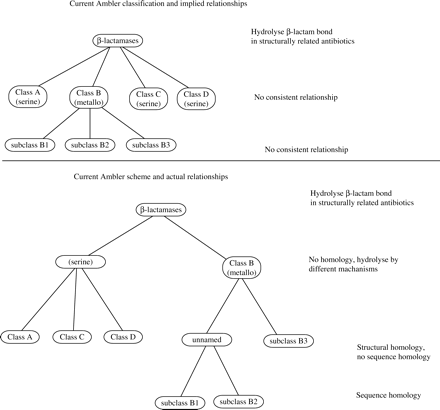-
PDF
- Split View
-
Views
-
Cite
Cite
Barry G. Hall, Miriam Barlow, Revised Ambler classification of β-lactamases, Journal of Antimicrobial Chemotherapy, Volume 55, Issue 6, June 2005, Pages 1050–1051, https://doi.org/10.1093/jac/dki130
Close - Share Icon Share
Sir,
β-Lactamases are the primary cause of bacterial resistance to β-lactam antibiotics. The most widely used classification of β-lactamases is the Ambler classification1 that divides β-lactamases into four classes (A, B, C and D) based upon their amino acid sequences. Ambler originally specified two classes: class A, the active-site serine β-lactamases; and class B, the metallo-β-lactamases that require a bivalent metal ion, usually Zn2+, for activity. Later a new class of serine β-lactamases was found that bore little sequence similarity to the then-known class A enzymes. Designated class C,2 its members are also known as the ‘AmpC’ β-lactamases. Another class of serine β-lactamases, familiarly known as the OXA β-lactamases, was found to bear little resemblance to either class A or class C and was designated class D.3 The three classes of serine β-lactamases are sufficiently different that alignment programs such as BLAST4 find no detectable sequence similarity,5 yet there is sufficient structural similarity among the three classes of serine β-lactamases that it is clear that they are homologous, i.e. descended from a common ancestor.
A similar situation exists for the metallo-β-lactamases, which are a group of enzymes with evolutionary origins that are independent of the progenitor of the serine β-lactamases. They hydrolyse β-lactams through an enzymic process that is distinctly different from that of the serine β-lactamases, and they are structurally unrelated to the serine β-lactamases. It is therefore appropriate that the metallo-β-lactamases should be grouped separately from the serine β-lactamases, and they are. All metallo-β-lactamases have been defined as class B β-lactamases. While this nomenclature accurately distinguishes the metallo-β-lactamases from the serine β-lactamases, it inaccurately implies that all of the metallo-β-lactamases are closely related to one another. This implication is inappropriate because not all metallo-β-lactamases are as closely related as their current grouping reflects. Within class B are enzymes that are alignable neither by DNA nor by protein sequence. Those well acquainted with the metallo-β-lactamases are aware of the differences that exist among the metallo-β-lactamases and have dealt with these differences by subdividing the class B group into three subgroups, B1, B2 and B3.6 However, in subdividing the class B in this manner, it is implied that all subgroupings of the class B enzymes are equal, and this is not the case. Members of subgroups B1 and B2 share sufficient sequence similarity that they are legitimate sequence-based homologues, but they share insufficient similarity with members of subgroup B3 to be legitimate sequence homologues of subgroup B3.7
The current nomenclature presents two immediate problems. The actual amount of diversity that exists among the metallo-β-lactamases is under-represented and is therefore scientifically misleading.
Because the metallo-β-lactamases are all contained in one group, it is implied that they can be treated as a cohesive group in sequence alignments and phylogenetic analysis. Alternately, if the subdivisions of class B are considered, then it is implied that each subclass should be treated as an equally separate group. Neither of these implications is correct (Figure 1).
Classification systems are inherently stable entities because changing systems inevitably introduces a period of some confusion. However, it is understood that classification schemes need to be updated as science increases our understanding of what we are defining. We do not suggest abandoning the Ambler classification system, but we do suggest that its utility could be improved through suitable modification. Because the β-lactamase classification system affects a wide group of investigators in a number of disciplines, any modification should be the subject of thoughtful discussion within the entire β-lactamase community and should be implemented on the basis of a consensus. As a starting point for discussion, we suggest that one alternative would be to designate two major groups: S, the serine β-lactamases; and M, the metallo-β-lactamases. Within those would be the classes SA, SC and SD, corresponding to the present classes A, C and D; and classes MB and ME, corresponding, respectively to the present class B subgroups B1 + B2, and class B subgroup B3. It would remain entirely legitimate to speak of MB1 and MB2, the two major subgroups corresponding to classes B1 and B2. That classification would facilitate addition of any newly discovered groups within either the serine or metallo-β-lactamases, and would if desired, permit the easy recognition of any major clades (subgroups) within any class.
Whatever renaming is agreed upon, we emphasize that for scientific clarity, it is important that class B1 and B2 be given an Ambler grouping that is distinctly different from that of the current class B3. While it may be argued that such a renaming will make little difference, it is better to correct a misleading classification system while it is easiest to do so.
References
Jaurin B, Grundstrom T. ampC cephalosporinase of Escherichia coli K-12 has a different evolutionary origin from that of β-lactamases of the penicillinase type.
Ouellette M, Bissonnette L, Roy PH. Precise insertion of antibiotic resistance determinants into Tn21-like transposons: nucleotide sequence of the OXA-1 β-lactamase gene.
Altschul SF, Madden TL, Schäffer AA et al. Gapped BLAST and PSI-BLAST: a new generation of protein database search programs.
Hall BG, Barlow M. Structure-based phylogenies of the serine β-lactamases.
Galleni M, Lamotte-Brasseur J, Rossolini GM et al. Standard numbering scheme for class B β-lactamases.
Author notes
1Biology Department, University of Rochester, Rochester, NY, USA; 2Department of Epidemiology, Rollins School of Public Health, Emory University, Atlanta, GA, USA




